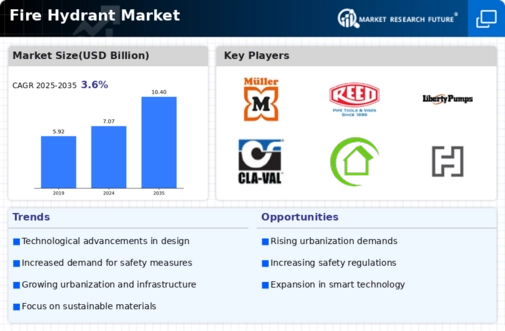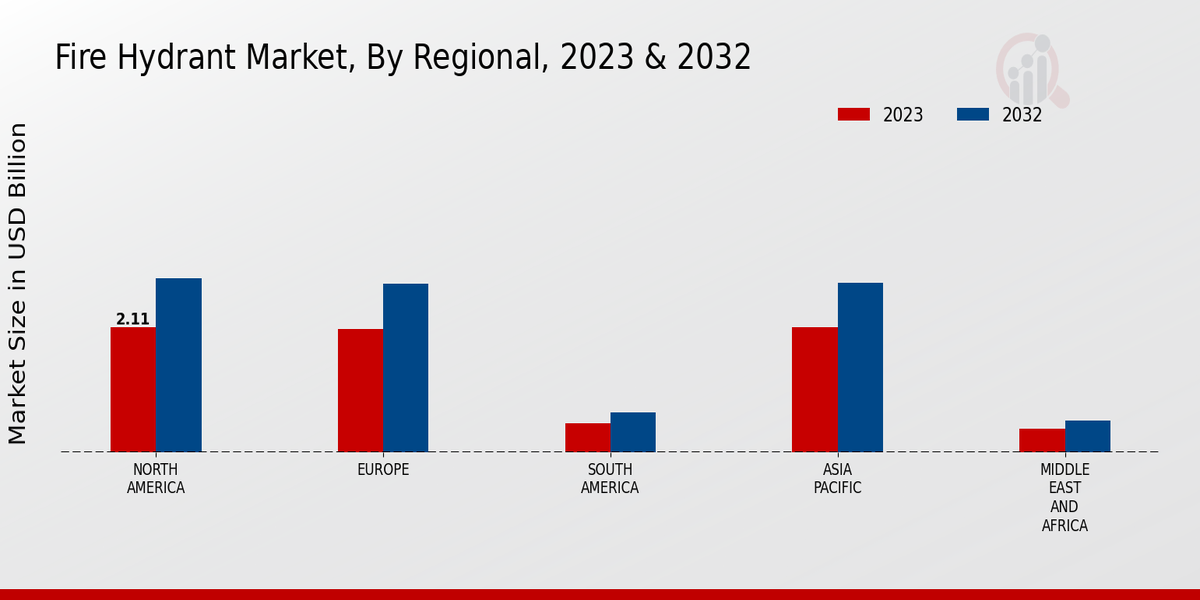Increasing Urbanization
The rapid pace of urbanization globally contributes significantly to the Global Fire Hydrant Market Industry. As cities expand, the demand for effective fire safety measures intensifies. Urban areas, characterized by dense populations and high-rise buildings, necessitate a robust fire hydrant infrastructure to ensure public safety. For instance, metropolitan regions are increasingly integrating advanced fire hydrant systems to meet safety regulations. This trend is expected to drive market growth, with projections indicating that the Global Fire Hydrant Market will reach approximately 7.07 USD Billion in 2024, reflecting the urgent need for enhanced fire protection in urban settings.
Technological Advancements
Innovations in fire hydrant technology are transforming the Global Fire Hydrant Market Industry. The introduction of smart fire hydrants equipped with sensors and remote monitoring capabilities enhances operational efficiency and response times during emergencies. These advancements allow for real-time data collection and analysis, enabling fire departments to optimize their resources effectively. For instance, cities that have adopted smart hydrant systems report improved fire response times and reduced maintenance costs. As the market evolves, the integration of such technologies is expected to bolster growth, contributing to an estimated market value of 10.4 USD Billion by 2035.
Market Trends and Projections
The Global Fire Hydrant Market Industry is characterized by various trends and projections that highlight its growth trajectory. As of 2024, the market is valued at 7.07 USD Billion, with expectations to reach 10.4 USD Billion by 2035. The compound annual growth rate (CAGR) from 2025 to 2035 is projected at 3.58%. These figures indicate a steady increase in demand driven by factors such as urbanization, regulatory compliance, and technological advancements. The market's evolution reflects a growing recognition of the importance of fire safety and the need for reliable fire hydrant systems across diverse regions.
Rising Awareness of Fire Safety
The growing awareness of fire safety among the public and businesses plays a crucial role in the Global Fire Hydrant Market Industry. Educational campaigns and training programs emphasize the importance of fire prevention and the role of hydrants in emergency response. This heightened awareness leads to increased investments in fire safety infrastructure, including the installation of hydrants in strategic locations. As communities recognize the value of proactive fire safety measures, the demand for fire hydrants is likely to rise, further propelling market growth. This trend aligns with the projected market expansion, indicating a robust future for the industry.
Global Infrastructure Development
The ongoing global infrastructure development initiatives significantly impact the Global Fire Hydrant Market Industry. Governments and private sectors are investing heavily in infrastructure projects, including roads, bridges, and public facilities, which necessitate the incorporation of fire safety measures. Fire hydrants are integral to these developments, ensuring that newly constructed areas are equipped with adequate fire protection. As urban and rural areas undergo modernization, the demand for fire hydrants is expected to surge, contributing to the overall market growth. This trend underscores the importance of integrating fire safety into infrastructure planning.
Regulatory Compliance and Safety Standards
Stringent regulatory frameworks and safety standards imposed by governments worldwide are pivotal in shaping the Global Fire Hydrant Market Industry. These regulations mandate the installation and maintenance of fire hydrants in both residential and commercial properties. Compliance with these standards not only ensures public safety but also mitigates the risk of fire-related incidents. For example, many countries have established guidelines that dictate the specifications and placement of fire hydrants. As a result, the market is likely to witness sustained growth, with an anticipated CAGR of 3.58% from 2025 to 2035, driven by the need for adherence to these regulations.











